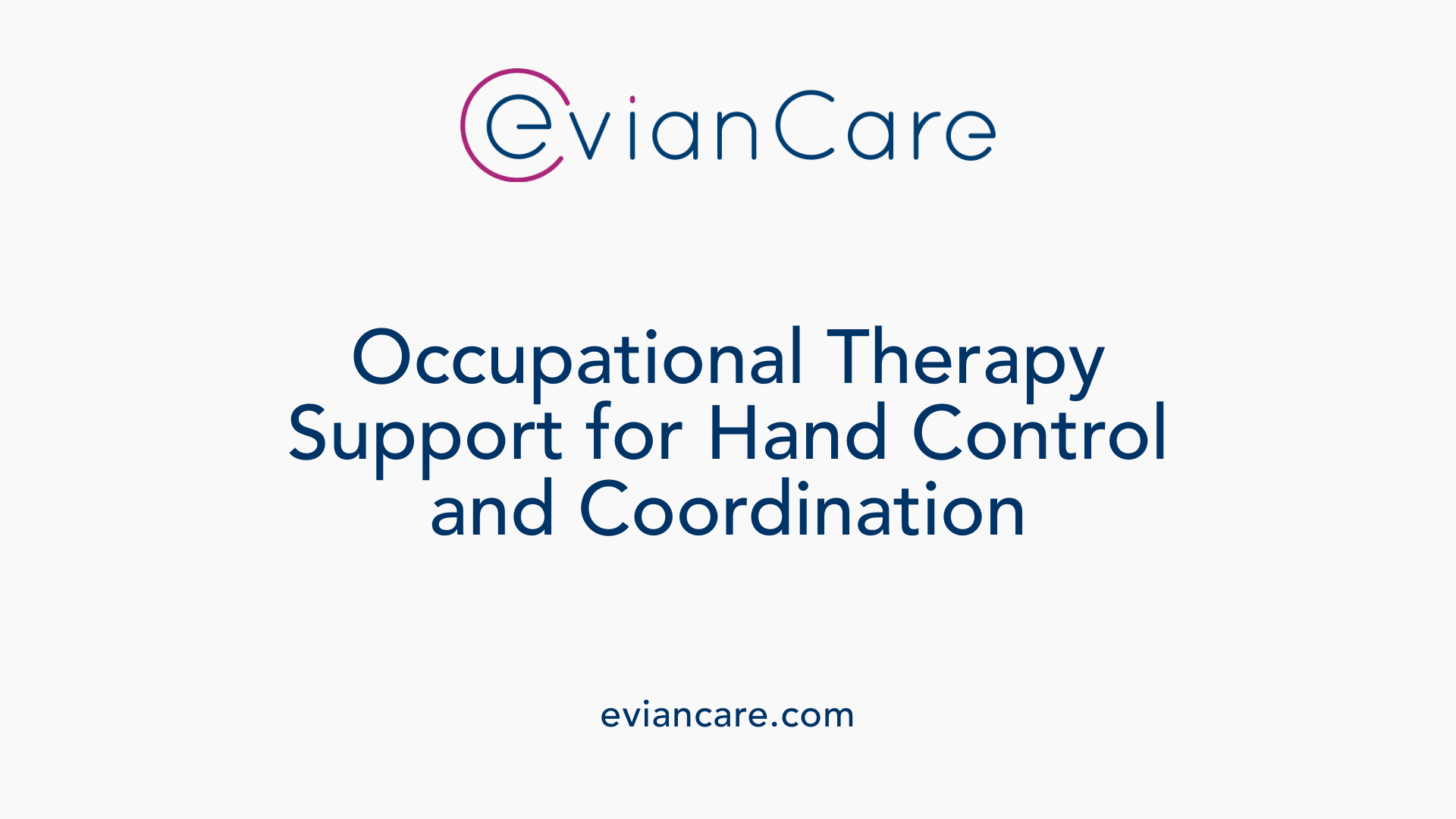
Understanding Hand Dominance and Its Importance
Hand dominance is a vital aspect of a child's motor development, reflecting how the brain prefers to use one hand over the other for skilled tasks. Its development begins early in childhood, typically between ages 2 and 4, and becomes more established by ages 4 to 6. Recognizing and fostering healthy hand dominance is essential for improving fine motor skills, coordination, and independence in daily activities. Occupational therapy plays a pivotal role in supporting this developmental milestone, ensuring children develop effective hand skills that impact their academic performance, self-care, and confidence.
Development of Hand Dominance in Children

What is hand dominance and how does it develop in children?
Hand dominance, or hand preference, refers to a child's tendency to favor one hand over the other when performing tasks. This preference emerges gradually through exploration, play, and practice, generally beginning around ages 2 to 4. During this developmental phase, children often experiment with both hands, which is a normal part of motor skill growth.
Most children establish a clear hand preference by age 4 to 6. However, it can take as long as age 8 or 9 for some to develop consistent dominance. Early on, children may switch hands frequently or use both hands interchangeably, especially as they learn to manipulate objects and develop coordination.
Careful observation of their activity patterns—such as which hand they reach with first, hold utensils, or use for drawing—can help identify their preferred hand. Encouraging activities like drawing, using scissors, or playing with toys can support and reinforce this development. Ultimately, hand dominance results from a combination of neurological, genetic, and environmental factors. Targeted motor practice and play-based activities assist in defining and strengthening a child's preferred hand, which aids in developing fine motor skills, coordination, and confidence.
Occupational Therapy Support for Hand Dominance Development
How do occupational therapists support the development of hand dominance in children?
Occupational therapists play a vital role in helping children establish and strengthen their hand dominance. They begin by carefully observing how children naturally use their hands during a variety of everyday activities such as drawing, cutting, playing, and building. This observation helps identify whether a child has a clear, consistent hand preference or if they switch hands, which can be normal at certain developmental stages.
Therapists then encourage children to use their preferred hand through targeted, play-based activities. These activities are designed to develop fine motor skills, improve bilateral coordination, and promote crossing the midline—an important step for task integration. Examples include stringing beads, completing puzzles, manipulating play dough, and engaging in games like 'Show Me' or Simon Says that require crossing the midline.
Positioning strategies are also recommended, such as placing toys and objects on the non-dominant side to promote reaching and use of the preferred hand. Consistent use of the dominant hand during dressing, eating, writing, and self-care tasks is reinforced with gentle guidance and encouragement.
Early assessment and personalized interventions are crucial, especially if a child shows signs of delayed or unclear hand dominance. By integrating these strategies, occupational therapists help children develop more efficient motor skills, which foster independence and boost confidence in daily activities.
Through specialized activities and attentive guidance, occupational therapy supports children in establishing a reliable hand preference, laying the foundation for improved hand control, coordination, and overall functional skills.
Techniques for Developing Hand Preference and Crossing the Midline

What techniques can help children develop hand preference and improve crossing the midline?
Developing a clear hand preference and crossing the midline is vital for children's fine and gross motor skills. Several activities and strategies can promote these skills effectively.
First, engaging children in activities that involve crossing the body's midline encourages the use of both hemispheres of the brain, enhancing coordination and hand dominance. Examples include reaching across the body to pick up objects, playing with toys on the opposite side of the dominant hand, or using both hands alternately during tasks.
Games like Twister or obstacle courses are excellent for practicing crossing the midline. These activities require children to stretch, bend, and reach across their bodies, naturally strengthening neural pathways.
Bilateral coordination activities, such as cutting with scissors, threading beads, coloring large pictures, or drawing figure eights, support the development of crossing the midline while also improving hand strength and control.
Positioning strategies in play and learning environments also matter. Placing toys or utensils on the non-dominant side prompts children to reach, cross, and use both sides of their body. Proper seating and spatial arrangements in classrooms can reinforce these movements.
Practicing these activities consistently between ages 2 and 6, with positive reinforcement and encouragement, helps in establishing a strong hand preference. As children practice crossing the midline regularly, neural connections involved in bilateral integration are strengthened, leading to better coordination and skilled hand use.
In summary, activities that involve side-to-side movement, engaging games, and strategic positioning are essential techniques for enhancing hand preference and midline crossing in young children, ultimately supporting their overall motor development and functional skills.
Role of Occupational Therapy in Addressing Hand Difficulites

How does occupational therapy support children with hand control and refine fine motor skills?
Occupational therapy (OT) plays a vital part in helping children develop and strengthen their hand skills. Therapists begin with a detailed assessment of a child's current hand control and fine motor abilities, observing how they manipulate objects, use tools, and perform daily tasks.
Once the evaluation is complete, OT interventions are tailored to meet each child's needs. These include activities that build hand strength, improve coordination, and promote proper grasp patterns. For example, therapists might incorporate exercises like squeezing stress balls, manipulating play dough, or threading beads.
Fostering bilateral coordination — the ability to use both hands together effectively — is crucial. Activities such as puzzles, stringing beads, or building blocks help children practice crossing the midline and using each hand purposefully.
What activities are used to improve hand strength and coordination?
Therapists recommend various play-based exercises that are both fun and functional. Common activities include:
- Drawing, coloring, and cutting
- Puzzles and matching games
- Playing musical instruments
- Outdoor activities like swinging or ball games
Strengthening exercises are also part of therapy plans. These might involve in-hand manipulation tasks such as rolling marbles or pinching clothespins, or using therapy tools like putty.
In addition, improving visual motor skills through activities like tracing, pasting, and connecting dots helps with handwriting and cutting tasks.
How are factors like posture, sensory processing, and core strength addressed?
Supporting hand control involves more than just the hands. Proper positioning at workstations or tables — with feet supported and arms resting comfortably — helps maintain focus and allows for better hand use.
Sensory processing skills are also integral. Therapists may incorporate sensory activities to improve body awareness and coordination, which in turn facilitate better hand control.
Core strength and postural stability are foundational. Exercises that strengthen the shoulders, back, and trunk enable children to sit upright and use their hands effectively during tasks.
Why is early intervention important?
Early involvement of occupational therapy can address hand control issues before they impact educational performance and daily independence. It can prevent problems like awkward handwriting, poor self-care, or frustration.
Supporting children in developing consistent hand dominance and bilateral skills not only enhances their motor proficiency but also boosts their confidence and participation in classroom activities.
What are some ways caregivers and teachers can support this progress?
Caregivers and teachers can encourage children to practice these skills through engaging activities like drawing, cutting, and playing with small toys at home and in school.
Maintaining communication with occupational therapists ensures that the strategies used are consistent and effective. With proper support, children can develop efficient, confident hand use, fostering independence and success in everyday tasks.
Supporting Children in Developing Healthy Hand Dominance

How can parents, educators, and therapists support children in developing healthy hand dominance?
Supporting a child's development of hand dominance involves a combination of engaging activities, careful observation, and positive reinforcement. Activities like drawing, cutting with scissors, dressing, and practicing self-care tasks encourage children to use one hand more consistently, fostering natural hand preference.
Parents and teachers should observe children during daily routines and play, noting which hand they use for tasks such as reaching, drawing, or eating. Recognizing early signs of hand preference, usually between ages 2 and 6, allows caregivers to support development appropriately.
Creating a supportive environment is essential. This includes positioning children correctly—such as supporting their arms and feet—and providing tools like safety scissors, appropriate writing utensils, and toys that promote unilateral hand use. Repetition of activities, making them enjoyable, and encouraging crossing the midline (for example, reaching across the body to pick up objects) strengthen hand control.
Positive feedback and avoiding pressure help children develop confidence and reduce frustration. Fun games like 'Show Me' or Simon Says further motivate children to use their preferred hand.
When there are concerns about delayed or inconsistent hand dominance, consulting an occupational therapist can provide tailored strategies. Early intervention may prevent future difficulties with handwriting, self-care, and coordination.
In summary, fostering consistent use of the preferred hand through playful, structured activities and environment support helps children develop strong, healthy hand dominance, which is vital for their overall motor skills and confidence.
Potential Challenges and Early Indicators of Developmental Difficulties

What are signs of inconsistent hand use, poor hand control, or delayed dominance?
Inconsistent hand use and poor hand control can manifest early in a child's development. Signs include difficulty in holding and using utensils properly, awkward pencil grasp, or trouble manipulating small objects like buttons or zippers. Some children may switch hands frequently while performing tasks such as drawing, cutting, or using toys, which may indicate delayed hand dominance.
Poor endurance during fine motor activities—like coloring, writing, or threading beads—is also a warning sign. They might tire quickly or seem frustrated when engaged in tasks that require dexterity. Messy handwriting, uncoordinated movements, or difficulty with self-care activities like brushing teeth or dressing can suggest underlying hand control issues.
Delayed or unclear hand preference, especially beyond age 6, could point to developmental concerns.
How might these signs suggest a link to developmental coordination disorder (DCD)?
Research shows that a lack of clear hand dominance or difficulty with bilateral coordination can be early signs of developmental coordination disorder (DCD). Zwicker, Missiuna, and Harris (2012) note that children who do not develop typical hand preference or struggle with fine motor tasks may be experiencing motor coordination challenges associated with DCD.
Children with DCD might exhibit clumsy movements, poor balance, and difficulty with tasks like catching or tying shoelaces. Early detection of inconsistent hand use and poor motor control is essential because it allows timely intervention, which can improve coordination, confidence, and daily functioning.
Why is early assessment and intervention important?
Early intervention can significantly influence a child's development. Addressing hand control issues promptly helps improve fine motor skills, handwriting, and self-care abilities.
Occupational therapists can assess a child's motor development, observe hand use, and recommend tailored activities to strengthen hand muscles and coordination. Strategies often include activities like drawing, cutting, and bilateral hand play, which encourage crossing the midline and hand dominance.
If unaddressed, hand control difficulties may lead to frustration, poor academic performance, or low self-esteem as children enter school age. Early assessment ensures that support is provided before challenges become more ingrained, promoting better independence and confidence in everyday tasks.
Empowering Children for Lifelong Motor Skills
Developing strong hand dominance and fine motor skills are critical for a child's independence, academic success, and confidence. Through targeted activities, regular practice, and professional support from occupational therapists, children can overcome challenges associated with hand control and coordination. Early assessment and intervention are vital to address delays, fostering neurological development and bilateral coordination. Parents, educators, and therapists together can create enriched environments that support children in achieving their full potential in hand skills, laying a foundation for lifelong functional abilities.












